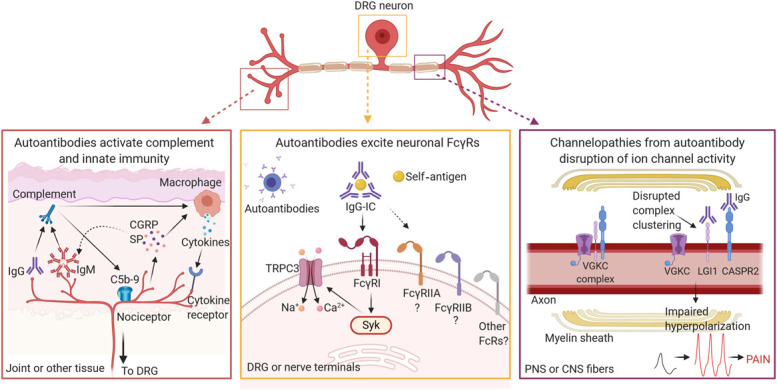Figure 1.

Autoimmune mechanisms influencing nociceptor hyperexcitability leading to chronic pain. Autoantibodies can cause nociceptor hyperexcitability and pain through multiple mechanisms across the neuraxis. In tissues such as the joint, accumulation of IgG and/or IgM autoantibodies can activate the complement system. Activation of subsequent complement proteins promotes inflammation and cytokine release from recruited macrophages (or other immune cells) and leads to tissue damage through accumulation of pore-forming membrane attack complex (C5b-9). Feedback from peripheral nociceptors also influences local tissue immunity by releasing neurotransmitters or peptides, such as CGRP or SP, to recruit or modulate the activity of immune cells, or to influence deposition of IgM. At the DRG cell body and its terminals, IgG-ICs bound to self-antigen activate FcγRs expressed on neurons. FcγRI can signal through Syk, causing release of intracellular stores of calcium that trigger opening of TRPC3 channels, depolarizing the cell leading to increased firing. Neuronal FcγRI activity is known to activate sensory neurons, yet it remains unknown if other classes of FcγRs are important for pain. At myelin sheaths on axons, IgG autoantibodies that target components of the VGKC complex disrupt appropriate channel clustering at juxtaparanodal regions, disturbing normal hyperpolarizing currents and leading to increased action potential firing. Collectively, the outcome of these autoantibody interactions is increased neuronal hyperexcitability, leading to pain. CASPR2, contactin-associated protein-like 2; CGRP; calcitonin gene-related peptide; CNS, central nervous system; C5b-9, complement 5b-9 membrane attack complex; DRG, dorsal root ganglia; FcγR, Fc gamma receptor; IgG, immunoglobulin G; IgG-IC, immunoglobulin G immune complex; IgM, immunoglobulin M; LGI1, leucine-rich glioma inactivated 1; PNS, peripheral nervous system; SP, substance P; SYK, spleen tyrosine kinase; TRPC3, transient receptor potential canonical 3; VGKC, voltage-gated potassium channel.
